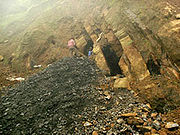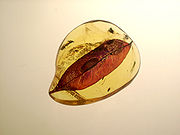
Dominican amber
Encyclopedia

Amber
Amber is fossilized tree resin , which has been appreciated for its color and natural beauty since Neolithic times. Amber is used as an ingredient in perfumes, as a healing agent in folk medicine, and as jewelry. There are five classes of amber, defined on the basis of their chemical constituents...
from the Dominican Republic
Dominican Republic
The Dominican Republic is a nation on the island of La Hispaniola, part of the Greater Antilles archipelago in the Caribbean region. The western third of the island is occupied by the nation of Haiti, making Hispaniola one of two Caribbean islands that are shared by two countries...
. Resin from the extinct species Hymenaea protera
Hymenaea protera
Hymenaea protera is an extinct prehistoric leguminous tree, the probable ancestor of present-day Hymenaea species. Most neotropical ambers come from its fossilized resin, including the famous Dominican amber.H...
is the source of Dominican amber and probably of most amber found in the tropics.
Dominican amber differentiates itself from Baltic amber
Baltic amber
The Baltic region is home to the largest known deposit of amber, called Baltic amber or succinite, with about 80% of the world's known amber found there. It dates from 44 million years ago...
by being nearly always transparent, and it has a higher number of fossil
Fossil
Fossils are the preserved remains or traces of animals , plants, and other organisms from the remote past...
inclusions. This has enabled the detailed reconstruction of the ecosystem of a long-vanished tropical forest.
Age
A study in the early 1990s returned a date up to 40 million years old. However according to Poinar, Dominican amber dates from OligoceneOligocene
The Oligocene is a geologic epoch of the Paleogene Period and extends from about 34 million to 23 million years before the present . As with other older geologic periods, the rock beds that define the period are well identified but the exact dates of the start and end of the period are slightly...
to Miocene
Miocene
The Miocene is a geological epoch of the Neogene Period and extends from about . The Miocene was named by Sir Charles Lyell. Its name comes from the Greek words and and means "less recent" because it has 18% fewer modern sea invertebrates than the Pliocene. The Miocene follows the Oligocene...
, thus about 25 million years old. The oldest, and hardest of this amber
Amber
Amber is fossilized tree resin , which has been appreciated for its color and natural beauty since Neolithic times. Amber is used as an ingredient in perfumes, as a healing agent in folk medicine, and as jewelry. There are five classes of amber, defined on the basis of their chemical constituents...
comes from the mountain region north of Santiago
Santiago de los Caballeros
Santiago de los Caballeros is a city in the Dominican Republic. Founded in 1495 during the first wave of European colonization of the New World, today Santiago is the second largest metropolis in the Dominican Republic, located in the north-central region of the Republic known as Cibao valley...
. The La Cumbre, La Toca, Palo Quemado, La Bucara, and Los Cacaos mining sites in the Cordillera Septentrional not far from Santiago
Santiago de los Caballeros
Santiago de los Caballeros is a city in the Dominican Republic. Founded in 1495 during the first wave of European colonization of the New World, today Santiago is the second largest metropolis in the Dominican Republic, located in the north-central region of the Republic known as Cibao valley...
. Amber has also been found in the south-eastern Bayaguana/Sabana de la Mar area. There is also subfossil copal
Copal
Copal is a name given to tree resin that is particularly identified with the aromatic resins used by the cultures of pre-Columbian Mesoamerica as ceremonially burned incense and other purposes...
found with an age of only 17-15 million years.
Mining sites

Dominican Republic
The Dominican Republic is a nation on the island of La Hispaniola, part of the Greater Antilles archipelago in the Caribbean region. The western third of the island is occupied by the nation of Haiti, making Hispaniola one of two Caribbean islands that are shared by two countries...
where amber is found: La Cordillera Septentrional, in the north, and Bayaguana and Sabana de la Mar, in the east. In the northern area, the amber-bearing unit is formed of clastic rocks
Clastic rocks
Clastic rocks are composed of fragments, or clasts, of pre-existing rock. Geologists use the term clastic with reference to sedimentary rocks as well as to particles in sediment transport whether in suspension or as bed load, and in sediment deposits.- Clastic metamorphic and igneous rocks :Clastic...
, washed down with sandstone
Sandstone
Sandstone is a sedimentary rock composed mainly of sand-sized minerals or rock grains.Most sandstone is composed of quartz and/or feldspar because these are the most common minerals in the Earth's crust. Like sand, sandstone may be any colour, but the most common colours are tan, brown, yellow,...
fragments and other sediments that accumulated in a deltaic
River delta
A delta is a landform that is formed at the mouth of a river where that river flows into an ocean, sea, estuary, lake, reservoir, flat arid area, or another river. Deltas are formed from the deposition of the sediment carried by the river as the flow leaves the mouth of the river...
environment, even in water of some depth.
In the eastern area, the amber is found in a sediment formation of organic-rich laminated sand, sandy clay, intercalated lignite
Lignite
Lignite, often referred to as brown coal, or Rosebud coal by Northern Pacific Railroad,is a soft brown fuel with characteristics that put it somewhere between coal and peat...
, and as well as some solvated
Solvation
Solvation, also sometimes called dissolution, is the process of attraction and association of molecules of a solvent with molecules or ions of a solute...
beds of gravel and calcarenite.
Both areas seem to have been part of the same sedimentary basin but were later disrupted by movements along major faults.
Mining

Blue Amber
Blue amber is amber exhibiting a rare coloration. It is most commonly found in the amber mines in the mountain ranges around Santiago, Dominican Republic...
is mined through bell pitting, which is extremely dangerous. The bell pit
Bell pit
A bell pit is a primitive method of mining coal, iron ore or other minerals where the coal or ore lies near the surface.. A shaft is sunk to reach the mineral which is excavated by miners transported to the surface by a winch and removed by means of a bucket, much like a well. It gets its name...
is basically a foxhole dug with whatever tools are available. Machetes do the start, some shovels, picks and hammers may participate eventually. The pit itself goes as deep as possible or safe, sometimes vertical, sometimes horizontal, but never level. It snakes into hill sides, drops away, joins up with others, goes straight up and pops out elsewhere. 'Foxhole' applies indeed: rarely are the pits large enough to stand in, and then only at the entrance. Miners crawl around on their knees using short-handled picks, shovels and machetes.
There are little to no safety measures. A pillar or so may hold back the ceiling from time to time but only if the area has previously collapsed. Candles are the only source of light. Humidity inside the mines is at 100%. Since the holes are situated high on mountainsides and deep inside said mountains, the temperature is cool and bearable, but after several hours the air becomes stale. During rain the mines are forced to close. The holes fill up quickly with water, and there is little point in pumping it out again (although sometimes this is done) because the unsecured walls may crumble.
Variations
Dominican amber can be found in many colors, besides the obvious amber. Yellow and honey colored are fairly common. There is also red and green in smaller quantities and the rare blue amberBlue Amber
Blue amber is amber exhibiting a rare coloration. It is most commonly found in the amber mines in the mountain ranges around Santiago, Dominican Republic...
(fluorescent).
The Museo del Ambar Dominicano, in Puerto Plata
San Felipe de Puerto Plata
San Felipe de Puerto Plata, often referred to as simply Puerto Plata, is the capital of the Dominican province Puerto Plata.The city is famous for resorts such as Playa Dorada and Costa Dorada, located east of San Felipe de Puerto Plata. There are a total of 100,000 hotel beds in the city.The only...
, as well as the Amber World Museum in Santo Domingo
Santo Domingo
Santo Domingo, known officially as Santo Domingo de Guzmán, is the capital and largest city in the Dominican Republic. Its metropolitan population was 2,084,852 in 2003, and estimated at 3,294,385 in 2010. The city is located on the Caribbean Sea, at the mouth of the Ozama River...
have collections of amber specimens.
Paleobiology
Numerous organisms have been described from amber specimens including:
Fauna
- AraneagryllusAraneagryllusAraneagryllus is an extinct monotypic genus of cricket in the subfamily Phalangopsinae with the sole species Araneagryllus dylani. The fossil was recovered in the Dominican Republic from early Miocene Burdigalian stage Dominican amber deposits on the island of Hispaniola...
- Augochlora leptolobaAugochlora leptolobaAugochlora leptoloba is a species of sweat bee in the genus Augochlora and the extinct monotypic subgenus Electraugochlora.-History and classification:...
- EickwortapisEickwortapisEickwortapis is an extinct monotypic genus of sweat bee in the Halictidae subfamily Halictinae and containing the single species Eickwortapis dominicana....
- ElectromyrmococcusElectromyrmococcusElectromyrmococcus is an extinct genus of mealybug in the Pseudococcidae subfamily Rhizoecinae. The genus currently contains three species, all from the early Miocene, Burdigalian stage, Dominican amber deposits on the island of Hispaniola....
- Leptofoenus pittfieldaeLeptofoenus pittfieldaeLeptofoenus pittfieldae is an extinct species of wasp in the family Pteromalidae known from early Miocene Burdigalian stage Dominican amber deposits on the island of Hispaniola...
- Lutzomyia adiketisLutzomyia adiketisLutzomyia adiketis is an extinct species of sandflies in the moth fly subfamily Phlebotominae. L. adiketis is a vector of the extinct Paleoleishmania neotropicum and both species are solely known from early Miocene Burdigalian stage Dominican amber deposits on the island of Hispaniola.-History and...
- Neocorynura electraNeocorynura electraNeocorynura electra is an extinct species of sweat bee in the Halictidae genus Neocorynura.N. electra is named from the Latin electrum meaning "amber". The species is known from a single female specimen, the holotype, deposited in the American Museum of Natural History, and which was first studied...
- NesagapostemonNesagapostemonNesagapostemon is an extinct monotypic genus of sweat bee in the Halictidae subfamily Halictinae. At present, it contains the single species Nesagapostemon moronei....
- OligochloraOligochloraOligochlora is an extinct genus of sweat bee in the Halictidae subfamily Halictinae. The genus currently contains six species, all of which are known from the early Miocene Burdigalian stage Dominican amber deposits on the island of Hispaniola....
- Paleoleishmania neotropicum
- TainosiaTainosiaTainosia is an extinct monotypic genus of planthopper in the Nogodinidae subfamily Nogodininae and at present, it contains the single species Tainosia quisqueyae...
- Termitaradus mitnickiTermitaradus mitnickiTermitaradus mitnicki is an extinct species of true bug in the family Termitaphididae known only from early Miocene Burdigalian stage Dominican amber deposits on the island of Hispaniola....
- Triatoma dominicanaTriatoma dominicanaTriatoma dominicana is an extinct species of assassin bug in the subfamily Triatominae, the kissing bugs known from early Miocene Burdigalian stage Dominican amber deposits on the island of Hispaniola.....
- Trypanosoma antiquusTrypanosoma antiquusTrypanosoma antiquus is an extinct species of kinetoplastid , a monophyletic group of unicellular parasitic flagellate protozoa....
- Sphaerodactylus dommeli
External links
- PBS NOVA "Amber: Jewel of the Earth"
- ISEM Research: Anolis lizard in amber
- American Museum of Natural History: Amber: Window to the Past, 1998
- Life in Amber includes numerous further links
- Christine Lipkin, "Geological setting and age of the Dominican Republic"
- Dominican Amber Mines: The Definitive List

